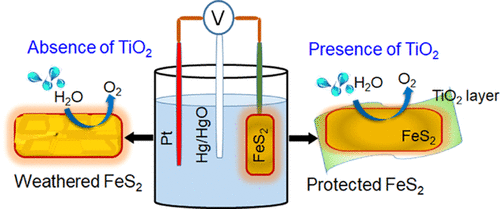当前位置:
X-MOL 学术
›
ACS Sustain. Chem. Eng.
›
论文详情
Our official English website, www.x-mol.net, welcomes your
feedback! (Note: you will need to create a separate account there.)
Physical Barricading at the Nanoscale: Protecting Pyrite from Weathering toward Efficient and Stable Electrocatalysis of the Oxygen Evolution Reaction
ACS Sustainable Chemistry & Engineering ( IF 7.1 ) Pub Date : 2020-09-21 , DOI: 10.1021/acssuschemeng.0c04756 Priyanka Pandey 1 , Soniya Gahlawat 1 , Pravin P. Ingole 1
ACS Sustainable Chemistry & Engineering ( IF 7.1 ) Pub Date : 2020-09-21 , DOI: 10.1021/acssuschemeng.0c04756 Priyanka Pandey 1 , Soniya Gahlawat 1 , Pravin P. Ingole 1
Affiliation

|
The unique atomic arrangement and excellent charge transfer properties of two-dimensional (2D) metal chalcogenides (MX2; M = transition metal, X = S, Se) make them effective electrocatalysts toward water splitting. But, so far, none of them have been able to replace noble-metal catalysts for the oxygen evolution reaction (OER), and it remains a great challenge to develop these catalysts. Specifically, cost-effective and earth-abundant FeS2 has shown potential, but it is less acknowledged due to the associated weathering process. Here, we report a spin-coated TiO2 layer on hydrothermally synthesized 2D-FeS2 nanoplates to control weathering through physical barricading at the nanoscale. Notably, the electrochemical and chemical weathering studies suggest that the TiO2 layer stabilized FeS2 oxidation in alkaline solution, while the latter gets oxidized without TiO2 overlayers. To the best of our knowledge, this would be the first report on an FeS2/TiO2 photoanode for efficient and stable OER without any composite or doping. It displayed improved long-term durability of OER activity. Moreover, the annealed crystalline leaky TiO2 layer (∼72 nm) remarkably displayed enhanced charge transfer at the FeS2/TiO2 interface. Also, Mott–Schottky measurements confirmed that the leaky TiO2 served as a protective layer (physical barrier) against the weathering of FeS2. The current study may provide new insights into the rational design of low-cost FeS2/TiO2 layered electrocatalysts for OER and renewable energy applications.
中文翻译:

纳米尺度上的物理屏障:保护黄铁矿免于风化,对氧释放反应进行有效和稳定的电催化
二维(2D)金属硫族化物(MX 2; M =过渡金属,X = S,Se)的独特原子排列和出色的电荷转移性能使其成为有效的水分解电催化剂。但是,到目前为止,它们中没有一个能够代替氧气发生反应(OER)的贵金属催化剂,开发这些催化剂仍然是一个巨大的挑战。具体而言,具有成本效益且富含地球的FeS 2已显示出潜力,但由于相关的风化过程,人们对其的认识较少。在这里,我们报道了在水热合成的2D-FeS 2上的旋涂TiO 2层纳米板可通过纳米级物理屏障来控制风化。值得注意的是,电化学和化学风化研究表明,TiO 2层在碱溶液中稳定了FeS 2的氧化,而后者在没有TiO 2覆盖层的情况下被氧化。据我们所知,这将是第一份有关FeS 2 / TiO 2光电阳极的报告,该光电阳极用于高效稳定的OER,而无需任何复合材料或掺杂。它显示出提高的OER活性的长期耐久性。此外,退火的晶体泄漏的TiO 2层(〜72 nm)在FeS 2 / TiO 2处显着增强了电荷转移接口。同样,Mott–Schottky测量结果证实泄漏的TiO 2可以作为保护层(物理屏障)来抵抗FeS 2的风化。当前的研究可能为用于OER和可再生能源应用的低成本FeS 2 / TiO 2层状电催化剂的合理设计提供新的见解。
更新日期:2020-10-21
中文翻译:

纳米尺度上的物理屏障:保护黄铁矿免于风化,对氧释放反应进行有效和稳定的电催化
二维(2D)金属硫族化物(MX 2; M =过渡金属,X = S,Se)的独特原子排列和出色的电荷转移性能使其成为有效的水分解电催化剂。但是,到目前为止,它们中没有一个能够代替氧气发生反应(OER)的贵金属催化剂,开发这些催化剂仍然是一个巨大的挑战。具体而言,具有成本效益且富含地球的FeS 2已显示出潜力,但由于相关的风化过程,人们对其的认识较少。在这里,我们报道了在水热合成的2D-FeS 2上的旋涂TiO 2层纳米板可通过纳米级物理屏障来控制风化。值得注意的是,电化学和化学风化研究表明,TiO 2层在碱溶液中稳定了FeS 2的氧化,而后者在没有TiO 2覆盖层的情况下被氧化。据我们所知,这将是第一份有关FeS 2 / TiO 2光电阳极的报告,该光电阳极用于高效稳定的OER,而无需任何复合材料或掺杂。它显示出提高的OER活性的长期耐久性。此外,退火的晶体泄漏的TiO 2层(〜72 nm)在FeS 2 / TiO 2处显着增强了电荷转移接口。同样,Mott–Schottky测量结果证实泄漏的TiO 2可以作为保护层(物理屏障)来抵抗FeS 2的风化。当前的研究可能为用于OER和可再生能源应用的低成本FeS 2 / TiO 2层状电催化剂的合理设计提供新的见解。









































 京公网安备 11010802027423号
京公网安备 11010802027423号